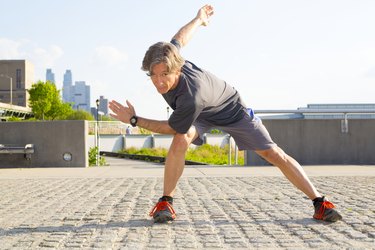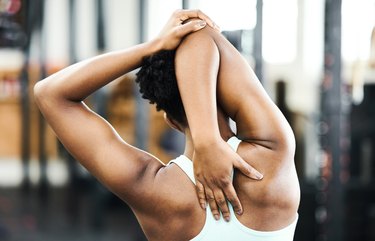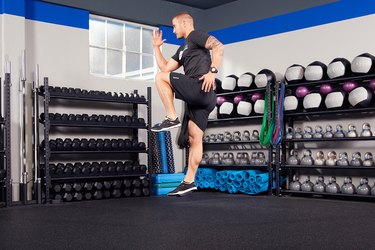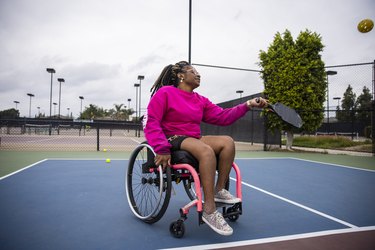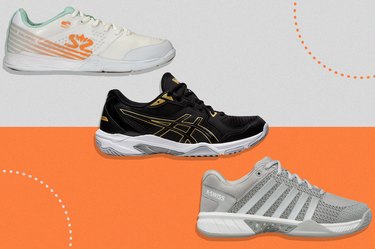
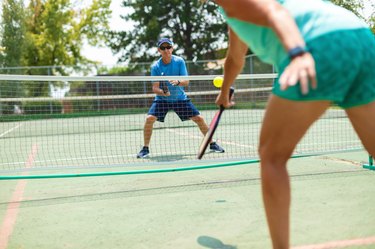
Pickleball is so fun and accessible that many players — newbies and veterans alike — grab a paddle, hit the court and start hitting balls back and forth right away, skipping a crucial part of a great game: the pickleball warmup.
"People are very anxious, and they just want to play," Gregory Storm, a PPR Pro-certified pickleball coach in St. Petersburg, Florida, and the CEO of the R.A.W. paddle brand, says.
Video of the Day
Video of the Day
Part of the reason pickleball has become a huge craze is because it's such a breeze to learn and a blast to play. "But that's a big problem: People are getting hurt because they're just not doing a 5 to 10 minute warm up before they get started," Storm says.
Even though pickleball is accessible to just about every level of fitness, that doesn't mean it's risk-free. In June, analysts from UBS estimated that pickleball will result in more than 66,000 visits to emergency departments this year in the United States. Some of the most common injuries on the court include sprained ankles, strained lower backs and achilles tendinopathy.
There's a simple tool that can help: A short warmup.
Here's how warming up can help reduce the risk of injuries that picklers face, info from experts on what makes a great pickleball warmup, and a simple, 10-minute routine you can do before and after you get on the court to have more fun, play better and reduce your risk of some of the most common pickleball injuries.
How Warming Up Can Help With Pickleball Injuries
While there aren't a lot of studies specifically targeting warmup routines and pickleball, evidence from other sports shows it can help with the same types of injuries experienced by picklers.
In one meta-analysis of studies published in May 2023 in Sports Medicine, scientists found that warmups that included some dynamic stretching improved injury outcomes in soccer players and in dancers. The results for dancers were especially interesting: Their ankle stability was improved, reducing potential sprains.
Another analysis on soccer warmups, from the December 2021 issue of the International Journal of Environmental Research and Public Health, found that players' balance was improved by warming up. That's significant for pickleball players, because many injuries involve losing balance and falling, according to Ernie Medina, a USA Pickleball ambassador and a certified Professional Pickleball Registry coach.
This can cause not just ankle and knee injuries, Medina says, but "wrist injuries, because [players] trip and fall, and they put their hands out to stop it," he says. "Also: Head injuries. If they're running backwards, they might catch their heel and fall backward — bang — they slam their head on the ground."
So warming up can help you stay on the court, protecting your ankles, knees, wrists, noggin and more. But it can also help you thrive on the court: When scientists looked at 32 different studies on warmups in an older but often-cited analysis in the January 2010 issue of the Journal of Strength and Conditioning Research, 79 percent of the warmup routines improved performance on the field or court. But, the scientists said, it's got to be the right kind of warmup.
What Makes a Good Pickleball Warmup?
The first thing a good warmup should do is literally warm you up, Darci Revier, CSCS, author of a recent guide for trainers called Conditioning for Pickleball, tells LIVESTRONG.com.
"We want it to be dynamic. So we're not holding static stretches, but we're working a joint and muscle group through increasing ranges of motion," she says. "At the same time, we're starting to elevate the heart rate a little bit."
Increasing heart rate literally "gets the blood moving," increasing circulation to the muscles, making muscles and tendons more supple and increasing body temperature just before game time without tiring players out.
These are some of the keys to the warmups that improved sports performance in the meta-analysis mentioned above. It's also important, according to that analysis, to warm up joints and muscles in the ways they'll be moved during the sport that's about to be played. For pickleball, that means a warmup that gets the following moving:
Shoulder Rotation
In a clinical recommendation for pickleball published in October 2020, the American College of Sports Medicine said that one of the main complaints from pickleball players visiting their doctors was shoulder pain. Their recommendation? Warm them up!
To do this, Storm likes to perform shoulder dislocates with a resistance band. In this move, straight arms are raised up and over the head until the band comes around and hits the exerciser on the low back or butt.
Don't have a band? Another option, Revier says, is arm circles: Start with small circles going forward, building to bigger and bigger circles. Then repeat going backward. Try these with your palms up and palms down.
Moving Side to Side
If it's been a while since you've played sports, you're likely not used to moving laterally, Revier says. In pickleball, you'll need to take lots of steps to your sides and at diagonals.
To get ready for this type of movement, she says players can perform simple side shuffles, as well as diagonal or lateral lunges. These lunges also help with the next movement skill for pickleball, lowering your center of gravity.
Getting Low
Not being able to bend your knees and lower your center of gravity to get to low shots can cause low back strains, Medina says, and can also cause players to lose their balance. When players aren't used to lowering their centers of gravity, they often bend by going onto one leg in a ballet shot: "They lean over to the right, and the left leg comes off the ground."
To stay out of this risky position, a warmup should help lubricate the ability to get low, Medina says. Squats and lunges help do the trick.
Trunk Rotation
Rotating your torso will create power in your shots, but it can also wrench your back. Warming up your spine with some gentle trunk rotations is key, Storm says.
Ankle Dorsiflexion
When your ankle extends so your toes can point, as when you go up on your toes, that's ankle flexion. Ankle dorsiflexion is the opposite, when your toes come up toward your shin. Many of us are not as mobile in this movement, Revier says, but it's key in pickleball: When you're running forward and you stop yourself, your ankle needs to dorsiflex.
To get ready for more dorsiflexion than we experience in daily life, Revier suggests including heel walks in your warmup, walking forward on your heels.
Pickleball Warmup: Before You Take the Court
Warming up before starting a game doesn't take much time or space, and doesn't require any equipment, Medina says. He suggests moving the length of a pickleball court — about 40 feet — for about five minutes, doing a series of moves that help prepare your body for what it'll need to do in your upcoming games.
Try this warmup routine composed of moves from Medina and Revier. Walk, march or lunge the length of the court for each step, doing the move described. Continue the series until you've warmed up for 5 to 10 minutes, running through it a second time if necessary. When you're finished, move on to the on-court drills in the next section.

- Length 1: Forward Arm Circles
- Length 2: Backward Arm Circles
- Length 3: High Knee March
- Length 4: Trunk Rotation March
- Length 5: Side Shuffle to Your Right
- Length 6: Side Shuffle to Your Left
- Length 7: Diagonal Walking Lunge
- Length 8: Heel Walks
- Finisher: 10 Supported Squats
How to Do Each Move
- Forward Arm Circles: Walk the length of the court doing arm circles that go forward. Start with small circles, and get bigger as you walk.
- Backward Arm Circles: Walk back to the start, but this time do arm circles to the back. Start with small circles, and get bigger as you walk.
- High Knee March: Perform a high-knee march for the length of the court, keeping an erect posture and bringing your knees up toward your waist.
- Trunk Rotation March: Place your hands on the sides of your head in a classic sit-up style. March again, but on each step, bring the opposite elbow to your knee. So when you raise your right knee, rotate your trunk to bring your left elbow toward the right knee.
- Side Shuffle: Stand sideways, bend your knees slightly, and shuffle the length of the court to your right. Return by shuffling to your left.
- Diagonal Walking Lunge: Stand with your feet shoulder-width apart. Imagine your feet are both facing 12 o'clock. Take a large lunge step forward with your right leg toward 2 o'clock, descending as you step until your knees both form 90-degree angles. Stand up, bringing your left leg to meet your right foot. Now lunge with your left foot, stepping toward 10 o'clock. Continue for one length of the court.
- Heel Walks: Raise your toes off the ground, and walk on your heels for one length of the court.
- Supported Squats: Holding onto a fence of the net post for support, do 10 body-weight squats.
Pickleball Warmup: After You Take the Court
Before you dive into your game, you'll want to warm up your pickleball skills, too. Storm says that many players start "dinking" — hitting balls back and forth — but they don't move enough.
Try the Slinky Drill
Instead of dinking like statues, Storm suggests grabbing a partner for the "Slinky Drill." This drill helps players get used to moving forward and backward, so they don't trip when backpedaling, and also prepares for hitting the ball from different positions and while moving — the way it happens in the game.
To do this drill, one partner stands on one side of the net on the "kitchen line," the horizontal line 7 feet from the net that demarcates the "no volley zone." This partner will stay here throughout the drill until it's their turn. We'll call this partner the "server."
The other, active partner starts on the "kitchen line" on the other side of the net. We'll call this partner the "mover." The server hits the ball over the net to the mover, who hits it back into the no volley zone with a forehand stroke. After doing so successfully, the mover takes one or two steps back. The server hits them the ball again, and they forehand it back over into the no volley zone.
This should continue — forehand stroke, then step back — until the mover reaches the back line. Then the mover comes forward on each stroke until they reach the kitchen line.
At this point, switch roles: The server becomes the mover, and performs forehand strokes until they've gone back and come back up. Once this is complete, repeat the drill, this time doing backhand strokes instead of forehands.
Play a Few Points of “Skinny Singles”
Singles pickleball can be really strenuous for newcomers, Medina says. To warm up for it, or even just to practice, try a few points of half-court pickleball, also called "skinny singles."
To play this way, you and a partner play normal pickleball, but you only use one half of each side of the net. You can both play on the same side — so your right side of the court, and their left, or vice versa — or on opposite sides, hitting across the court to each other diagonally. The other sections of the court are out in skinny singles.
This reduces the court space by half, letting you warm up for a game without tiring yourself out, or without having to move in ways you're not ready to yet. Play a short game or a few points of skinny singles, Medina says, and you'll be more prepared to step up to the full court — or be more warmed up to dominate your doubles game.
